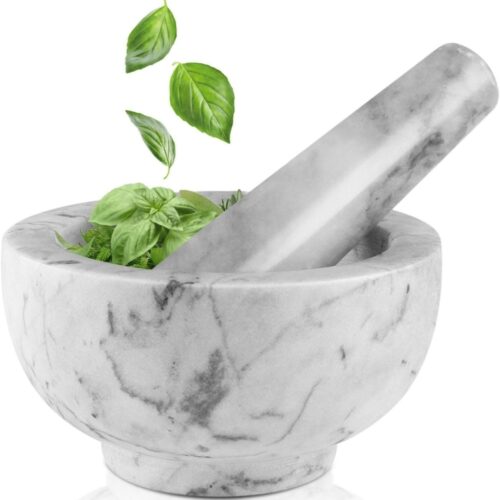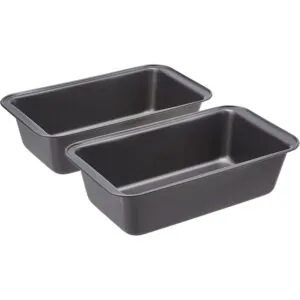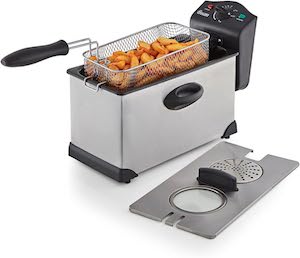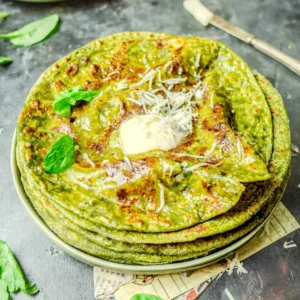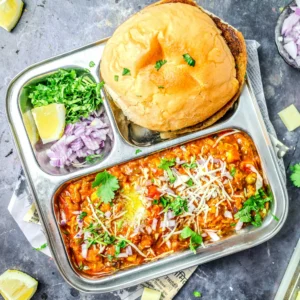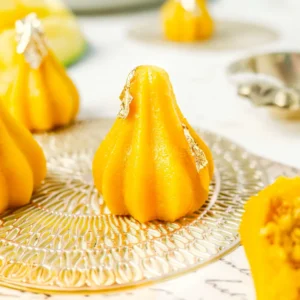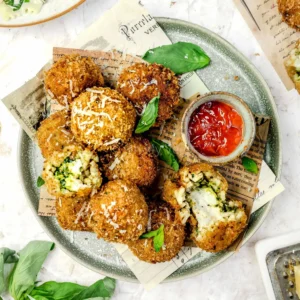Kothimbir Vadi
Let me introduce you to kothimbir vadi: Herby, crispy, nutty, and irresistibly good Maharashtrian fried snacks made with coriander leaves, chickpea flour, and spices.
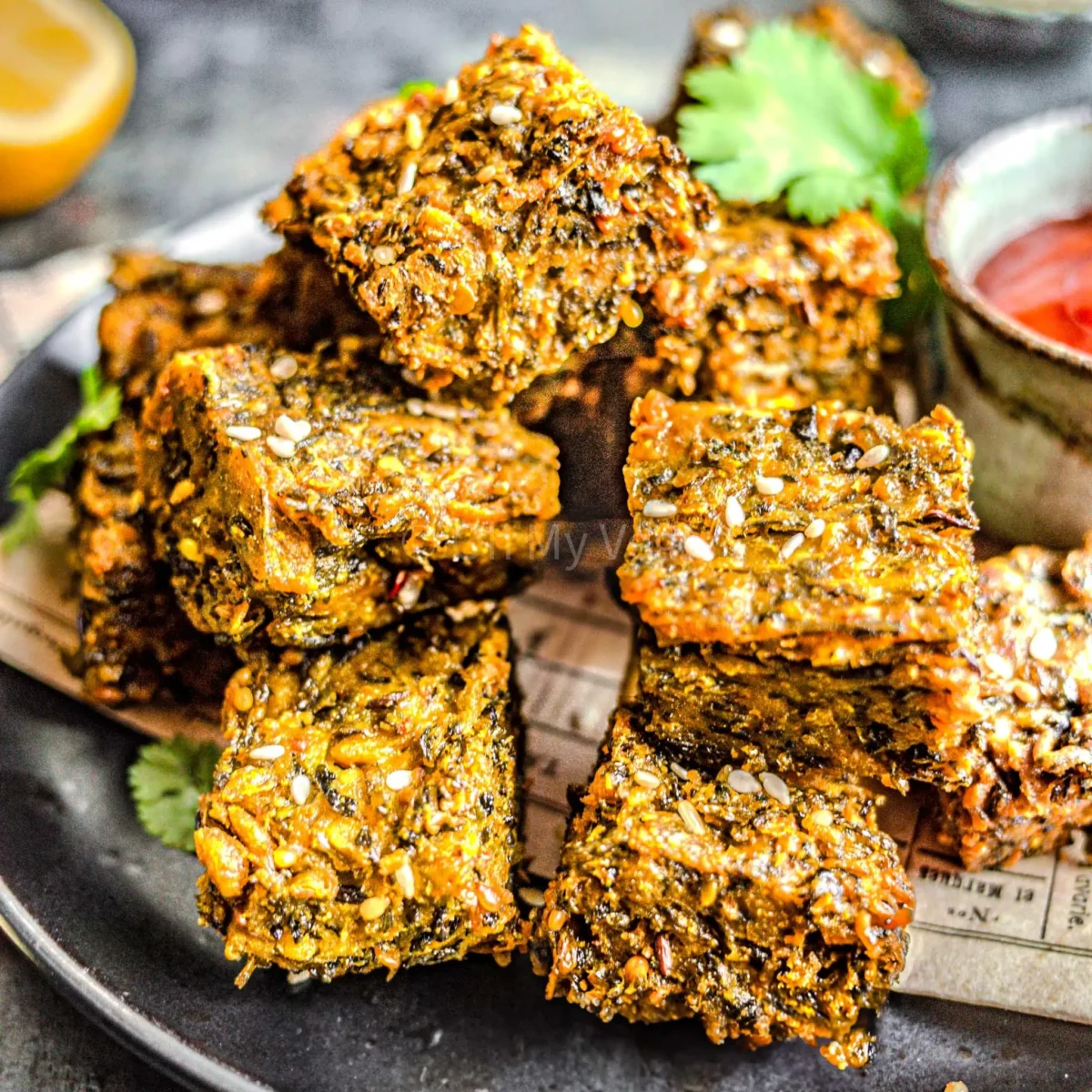
During all my years living in the U.K., I haven’t found a single restaurant that serves kothimbir wadi. I can’t believe my country is sleeping on one of the best Indian snacks I’ve ever tasted!
I’ve realised that’s often the case with Indian recipes. There’s a whole world of deliciousness out there that most people outside of India never encounter. I feel so lucky to be the exception and to share these stunning plates with my readers.
It wouldn’t be an exaggeration to say it was love at first bite when I first tasted kothimbir vadi (not in a restaurant, but in an Indian home!). If you’ve had the dish before, you know what I’m talking about. It’s like an upgraded pakora.
If you haven’t had the privilege of trying kothimbir wadi yet, don’t worry. I’ll explain everything you need to know … and just you wait for the magnificent flavours you’ve got in store!
💚Why You Need This Kothimbir Vadi Recipe
❓What is Kothimbir Vadi
Kothimbir vadi is a crispy pakora-like snack made from chickpea flour, fresh coriander (cilantro), spices, and sesame seeds. It’s usually steamed, cut, then fried, although there are multiple ways to cook the dish (more on this later!).
In Marathi, “kothimbir” means coriander leaf and while “vadi” doesn’t have a direct translation, it always refers to a crispy item. Kothimbir vadi shouldn’t be mistaken for sambharvadi, a Nagpuri snack that also has the same translation (and similar flavours!).
Characteristically of Marathi food, kothimbir wadi are spicy and overloaded with incredible flavours.
Kothimbir Vadi is From Which State in India?
Kothimbir vadi has origins in Maharashtra, a state in Western India.
Other Maharashtrian dishes you may know include misal pav, sabudana vada, pav bhaji, onion bhaji, vada pav, and bharli vangi (among many other more regional specialties!)
Maharashtra food is famous worldwide, especially for how heavily it’s represented in the Indian street food scene. If you love watching foodie YouTube videos like me, you’ve probably seen countless people covering trendy Mumbai street food stalls.
However, dishes that deserve equal attention and yet are woefully underrepresented are Maharashtrian home-style dishes — for example, matki usal, thecha bhakri, and these kothimbir vadi. I love street food as much as the next person, but these authentic, homely recipes are the real deal.
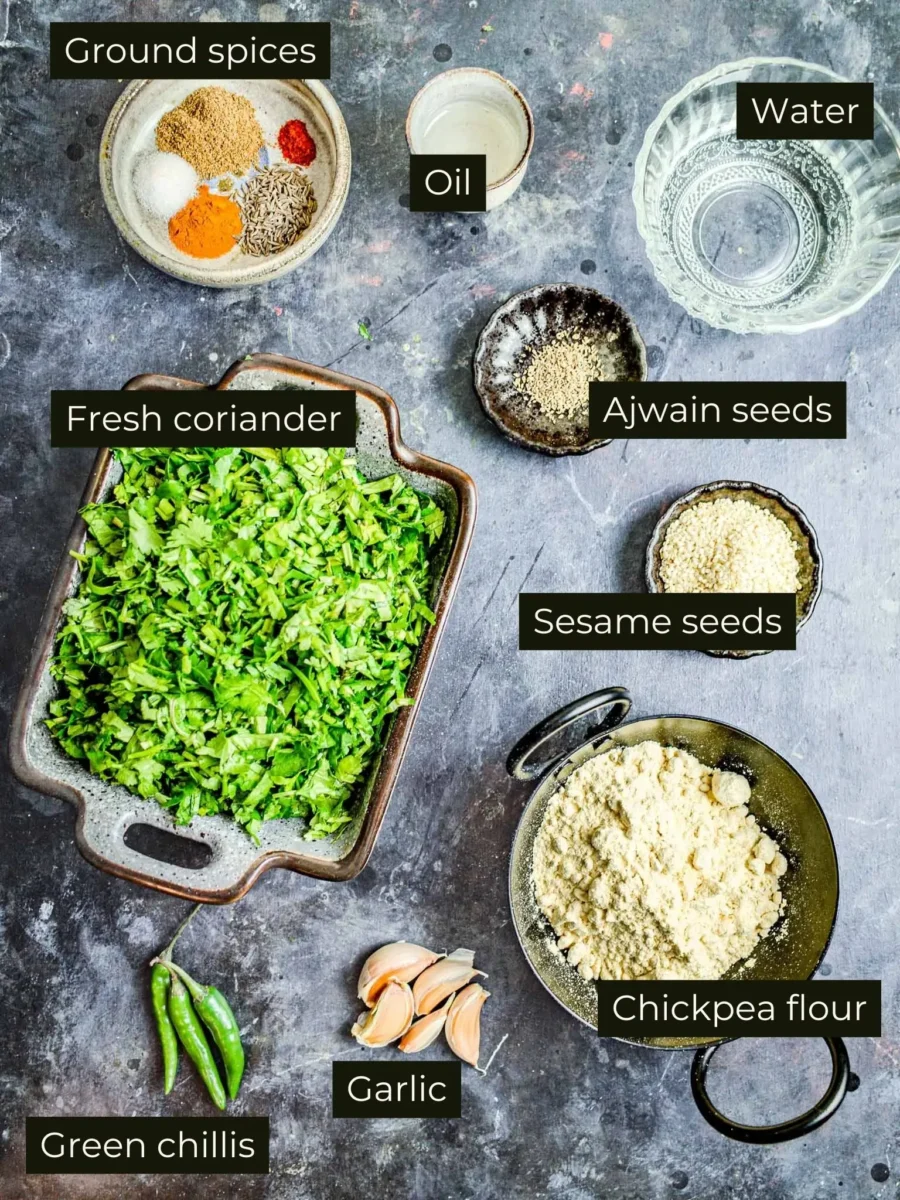
🌿What is Kothimbir Vadi Made Of?
You won’t need anything fancy — just a big bunch of coriander, a few spices, and a bag of chickpea flour.
If you don’t cook Indian recipes regularly, you might need to pop over to your local Indian market for a great quality spices and coriander (the supermarket stuff is often sub-par). If you don’t have an Indian store nearby, check online retailers who deliver!
- Coriander: Otherwise known as cilantro (American English), dhaniya (Hindi) or kothimbir (Marathi), the herb has a delicious citrusy, fresh, and peppery flavour. It’s not usually a hero ingredient, but these kothimbir wadi are allllll about the coriander.
- Chickpea flour: AKA besan or garbanzo bean flour. This naturally gluten-free flour is made from split chickpeas (as the name suggests!) and boasts a naturally nutty taste. It’s essential for lots of Indian snacks, including gluten free onion bhaji, kothimbir vadi, and batata vada.
- Green chilli: Kothimbir vadi should be spicy, and most of that heat comes through the sharp, fruity piquancy of green finger chillies. I use jwala chillies, an Indian variety with moderate heat and an apple-like taste.
- Garlic: Traditionally added in some homes as it offers buttery richness. Optional.
- Ajwain: I invariably add ajwain to every pakora-adjacent Indian dish. It’s complex flavour with the scent of thyme, flavour of oregano, and subtle hints of sharp and bitter bite, are a must-add.
- Cumin seeds: Pungent, warm, and nutty.
- Sesame seeds: Echoes the nuttiness of the gram flour. Use unroasted raw sesame seeds (we’ll cook them ourselves).
- Oil: Use neutral oil or groundnut oil for more flavour.
- Ground spices: Including turmeric (colour and earthy bitterness), red chilli (fiery smoky warmth), coriander powder (lemony, aromatic, and sweet), and salt to enhance all the savoury notes.
🌶️Ingredient Variations and Substitutions
There’s no ONE way to make kothimbir vadi. Like most homely recipes, each house across Maharashtra has a distinct recipe. While this may be my favourite, here’s a few ways you can alter it to fit your preferences.
First, let’s go over dietary/lifestyle substitutions:
- You might be wondering … is kothimbir vadi gluten free? Yes, these tasty Maharashtrian fritters are 100% gluten free and celiac friendly. Chickpea flour has no gluten, as it’s made entirely from pulses. You can even add a touch of rice flour to crispen things up even further, while keeping the recipe gluten free!
- Kothimbir vadi is also 100% vegetarian, vegan, and dairy free. No adjustments needed!
- This recipe is also nut free, BUT it does contain sesame seeds. Although they are generally safe to consume if you have a tree nut allergy, it’s best to consult with your Doctor if you’re unsure.
- Finally, kothimbir vadi without garlic is a Jain-friendly version that’s a breeze to adapt. Just switch out fresh garlic for a pinch of asafoetida/hing, which delivers the same pungent aroma and garlicy flavour.
Easily adjust the spice levels to a milder level by using just one green chillies and swapping regular red chilli powder for milder (yet just as flavoursome!) Kashmiri chilli powder.
Or, if you’re a chilli-head, play around with super-hot varieties like ghost peppers or Naga chillies. Be careful not to overwhelm the flavour, though! You might prefer serving a chilli pickle on the side, instead.
Some kothimbir vadi recipes add peanuts. I also love to on occasion, but I omitted them from this recipe to make it nut free. If you’d like to add peanuts, simply roast them until slightly charred, then pound in a mortar and pestle (or chop) to a coarse consistency.
♨️How is Kothimbir Vadi Made? (Step-by-Step Photos)
Now, my way of cooking kothimbir vadi isn’t the most popular. But, it is easier … and there’s no difference taste-wise, so I’m not sure why more people aren’t making kothimbir vadi without steaming! Check out my stepwise photos:
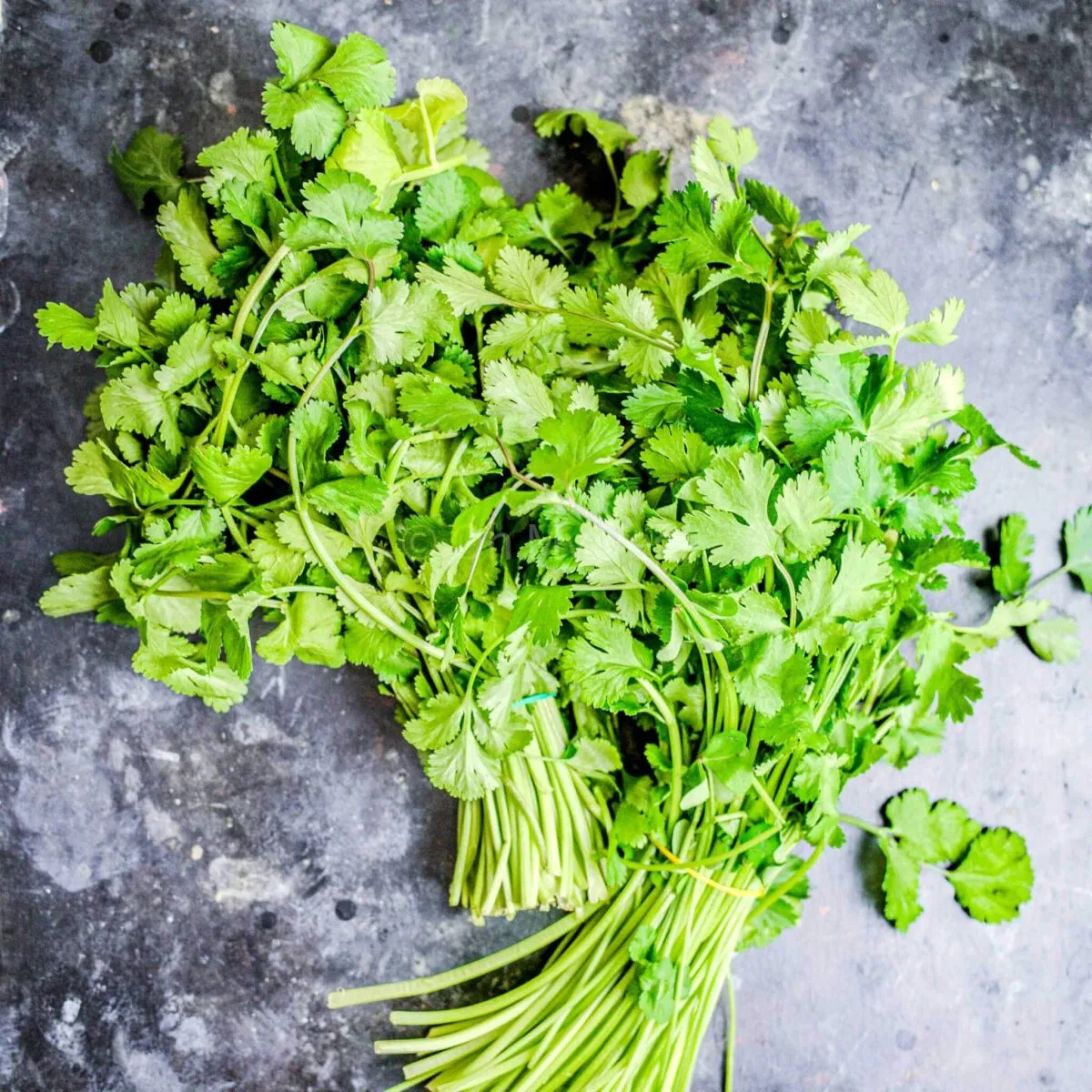
One: Wash, dry, and roughly chop fresh coriander.
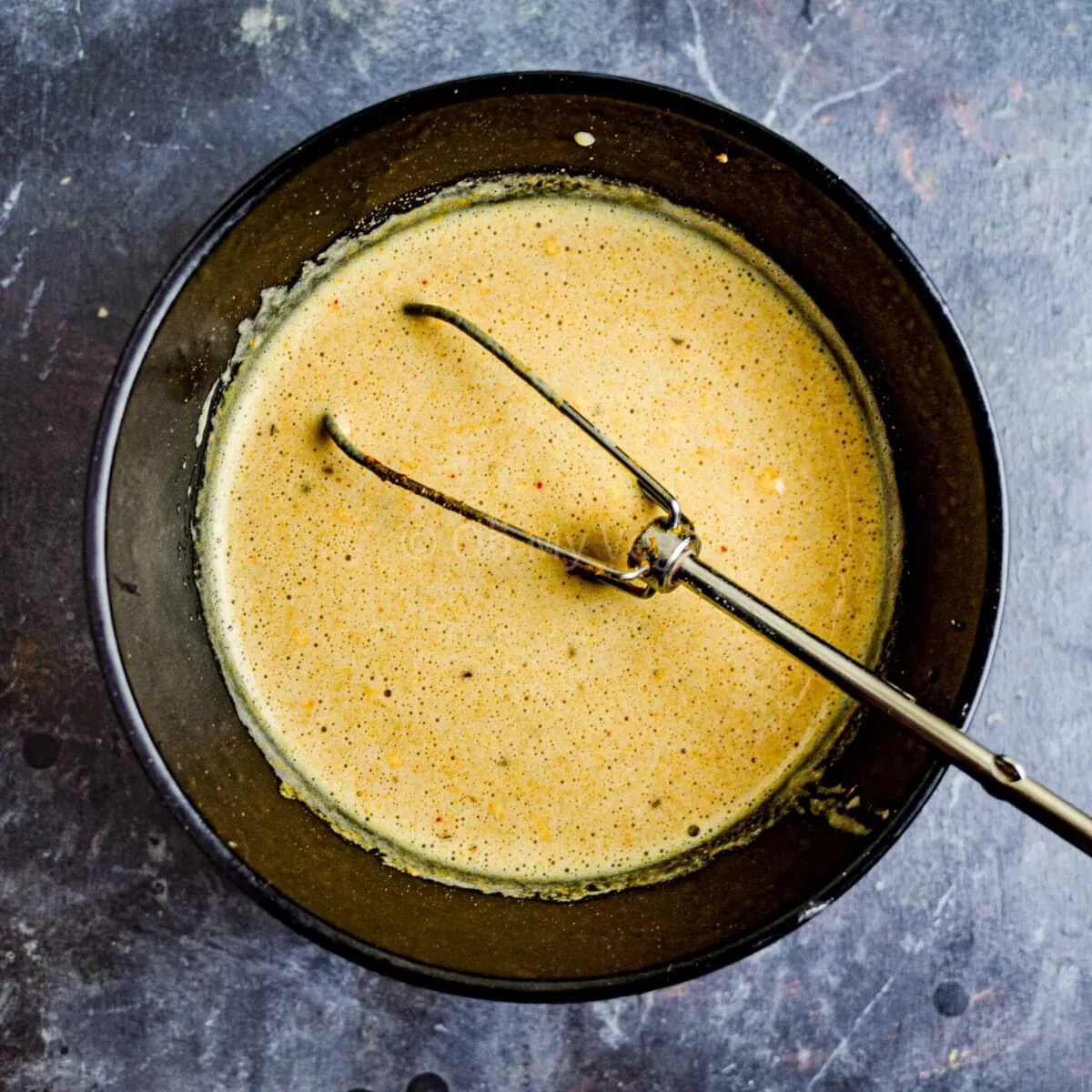
Two: In a bowl, whisk chickpea flour and water. It should be a smooth batter.
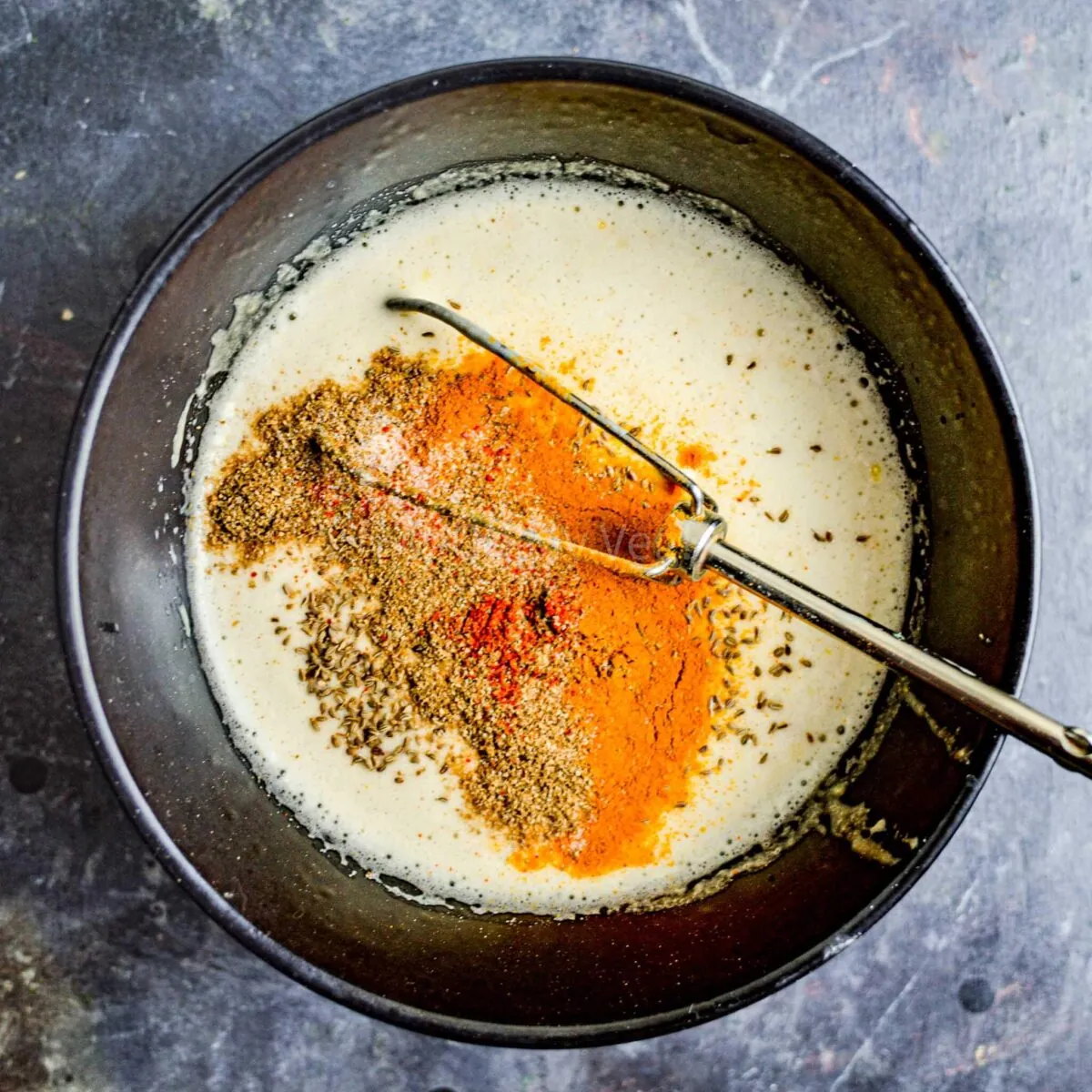
Three: Stir in the ground spices (turmeric, red chilli, and coriander powder) as well as salt to taste.
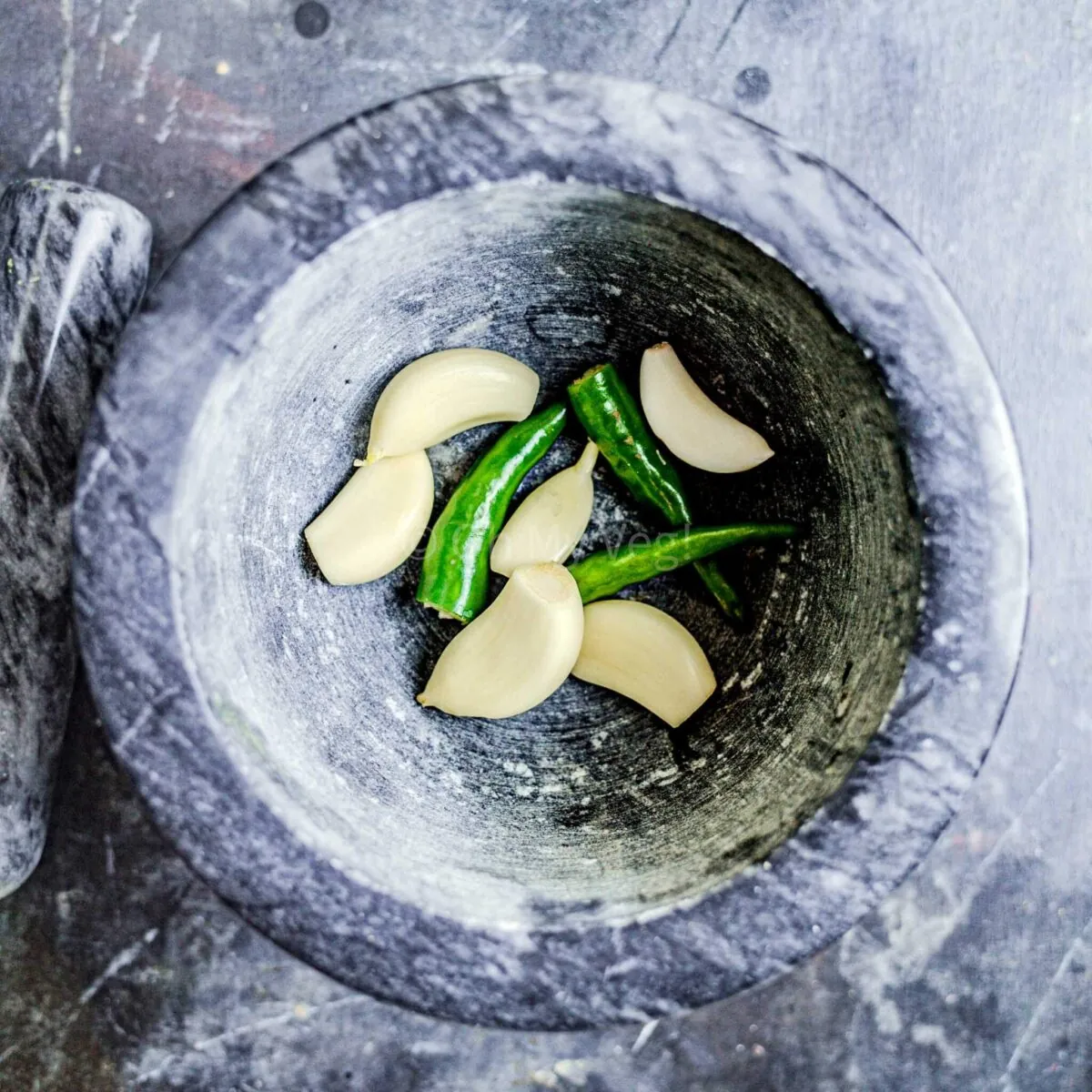
Four: In a mortar and pestle, add garlic and green chillies.
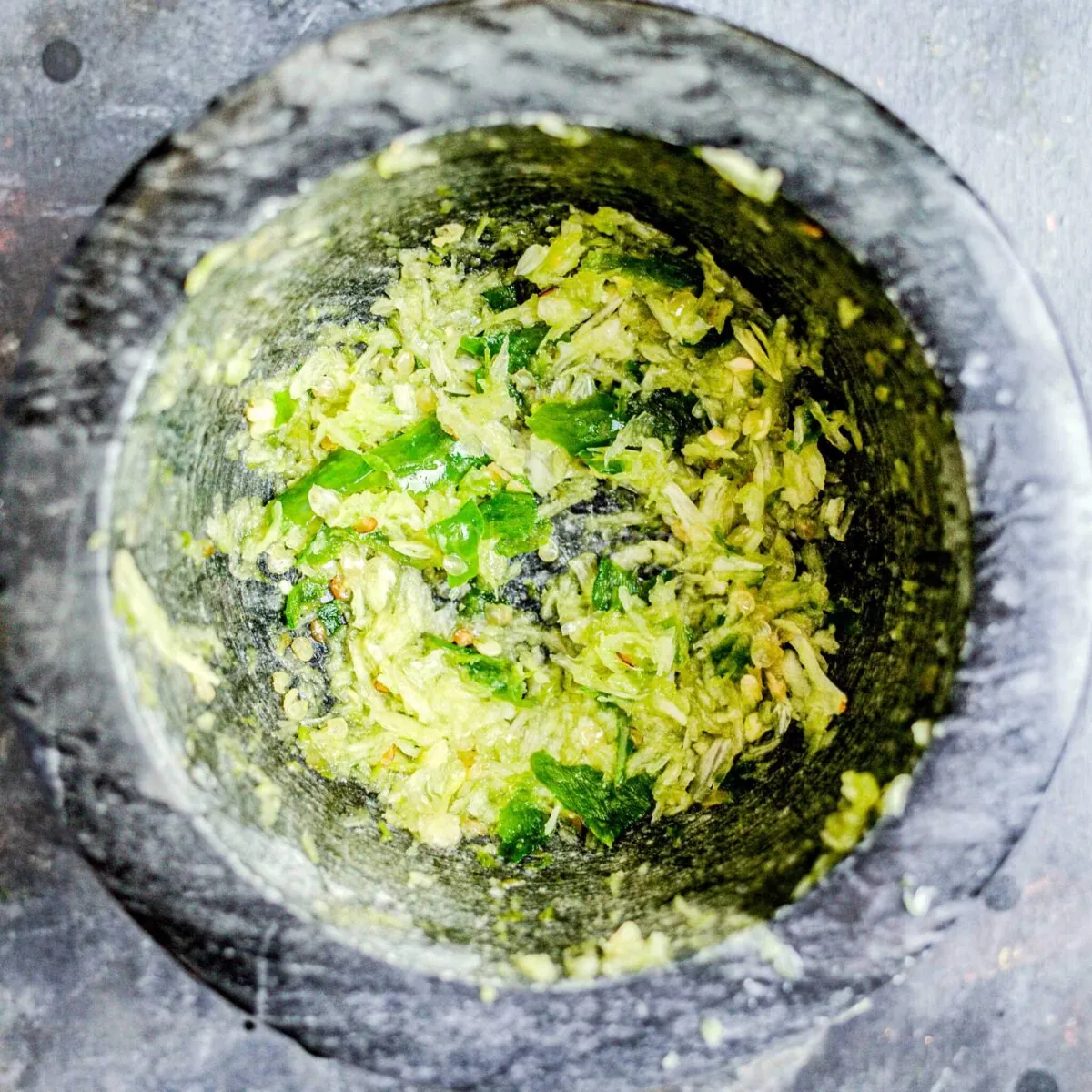
Five: Roughly pound the mixture until broken down. It doesn’t need to be a proper paste!
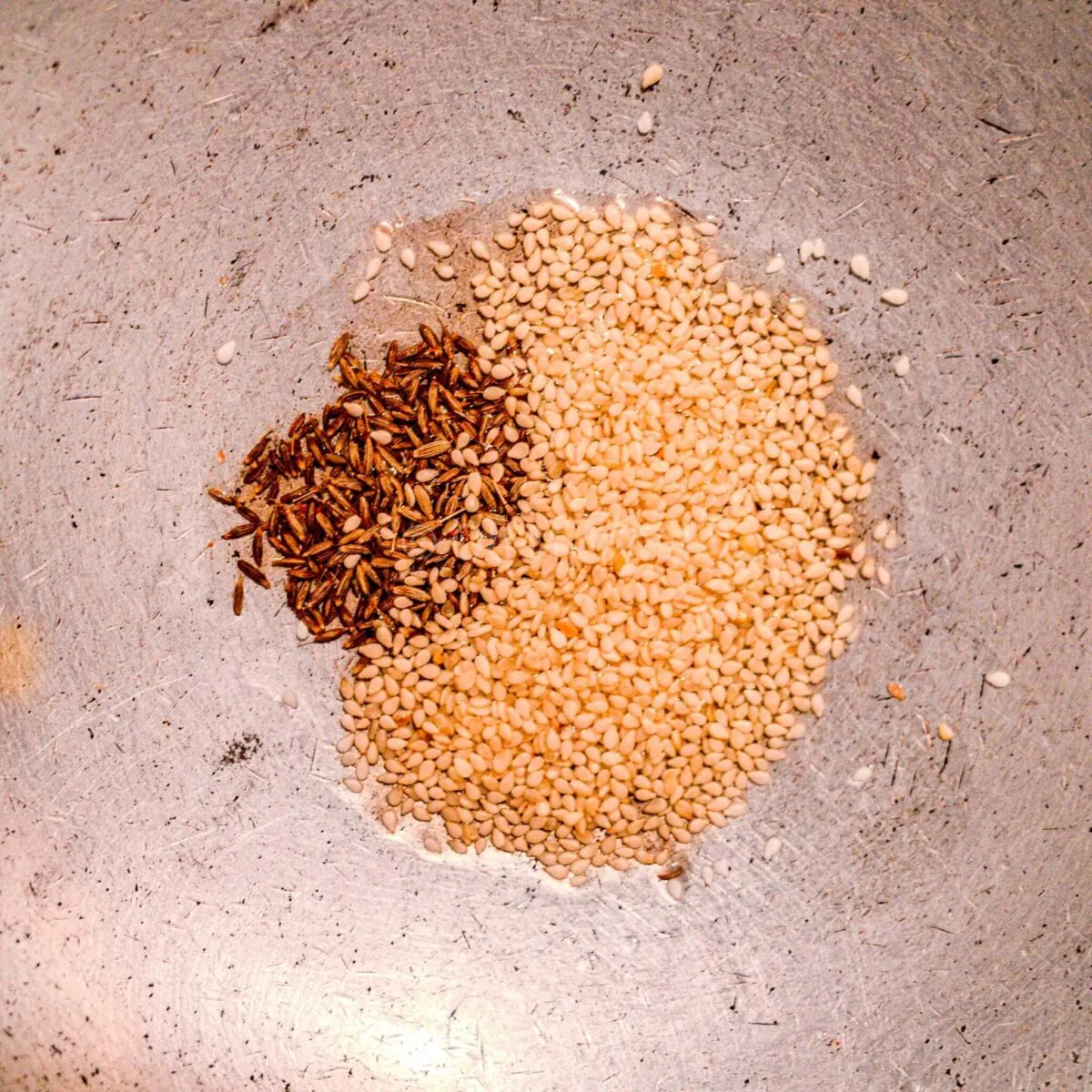
Six: Heat oil in a large kadai or frying pan. Once hot, add cumin and white sesame seeds.
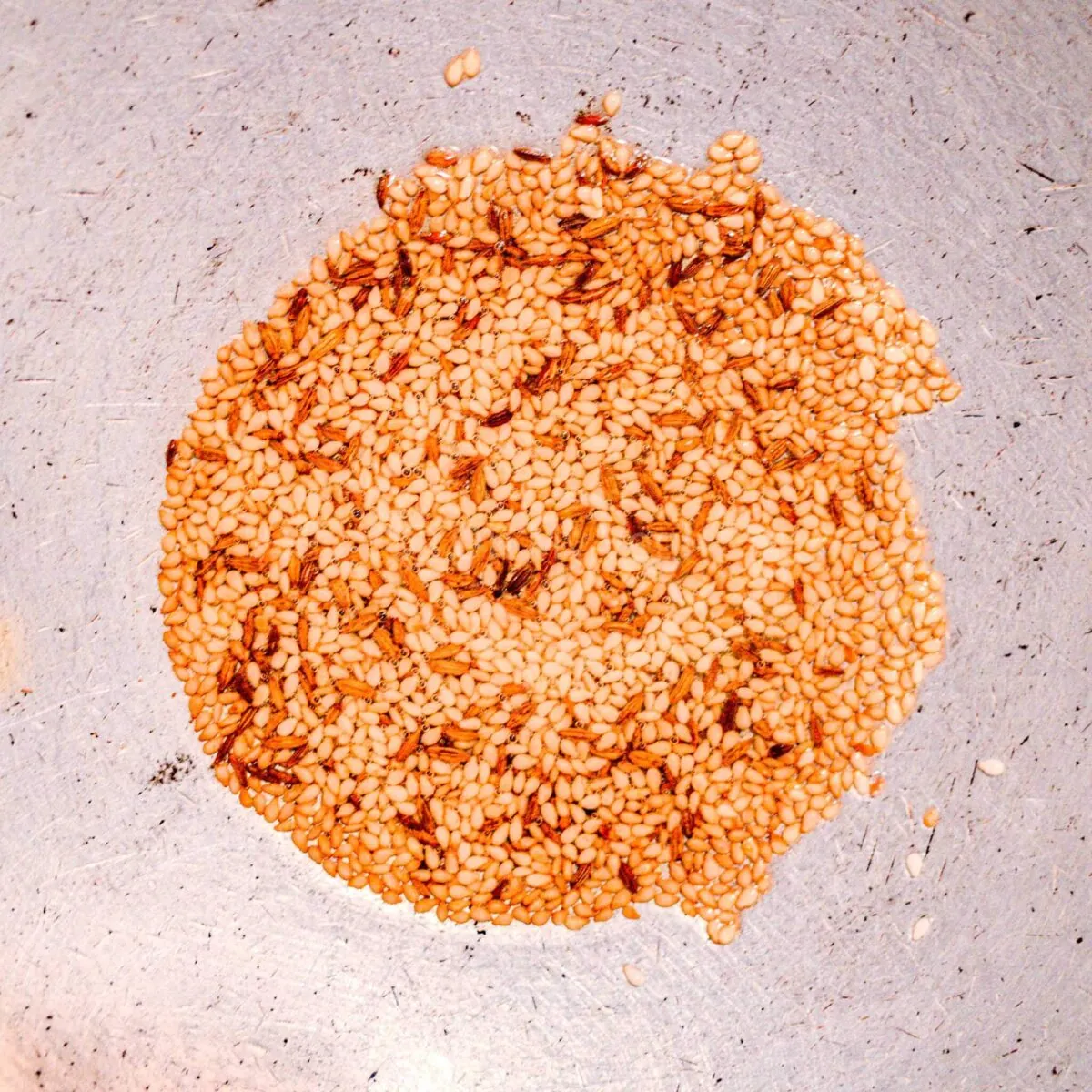
Seven: Sauté the seeds until aromatic and slightly golden.
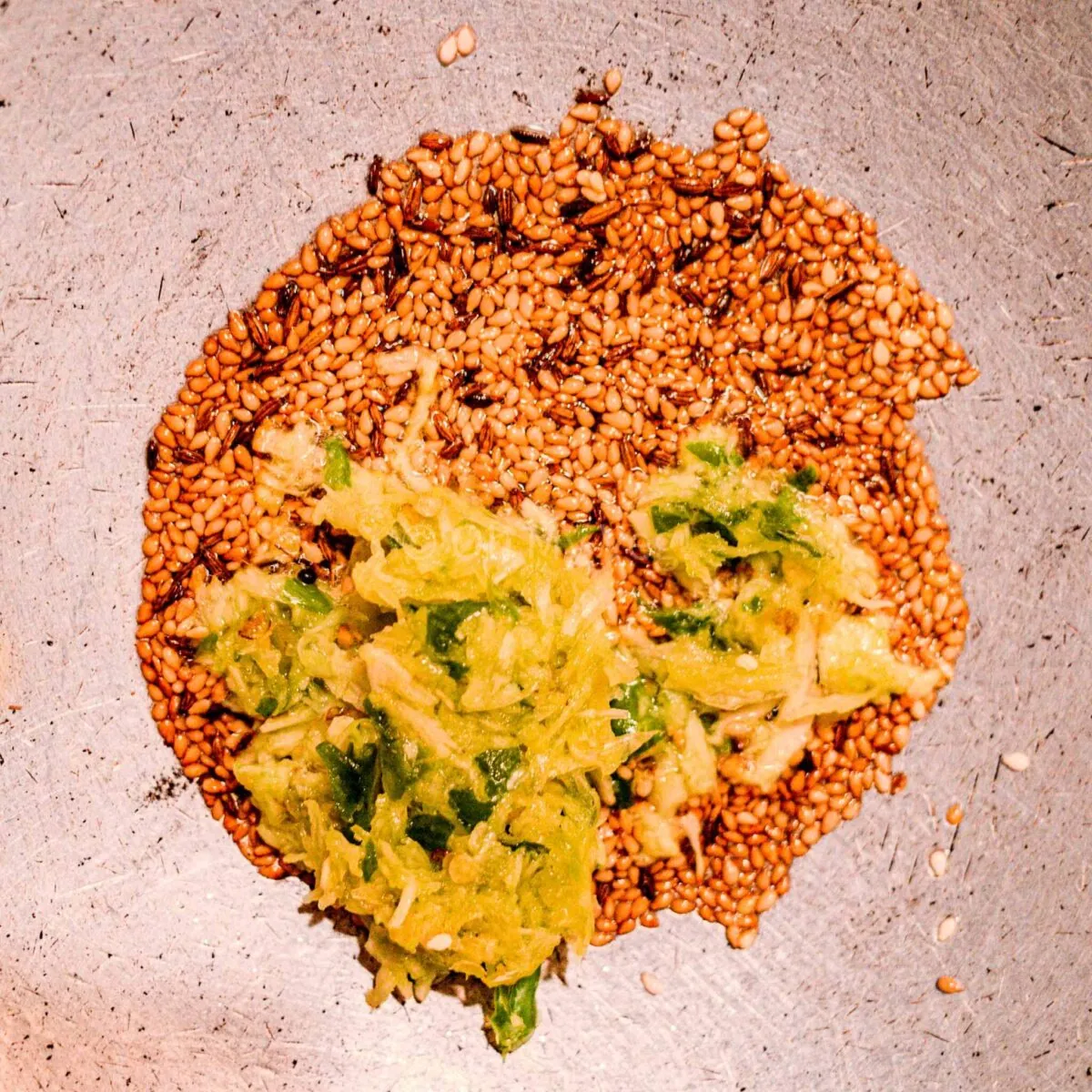
Eight: Add the crushed garlic and green chilli paste to the pan.

Nine: Cook for a few seconds until the raw smell fades.
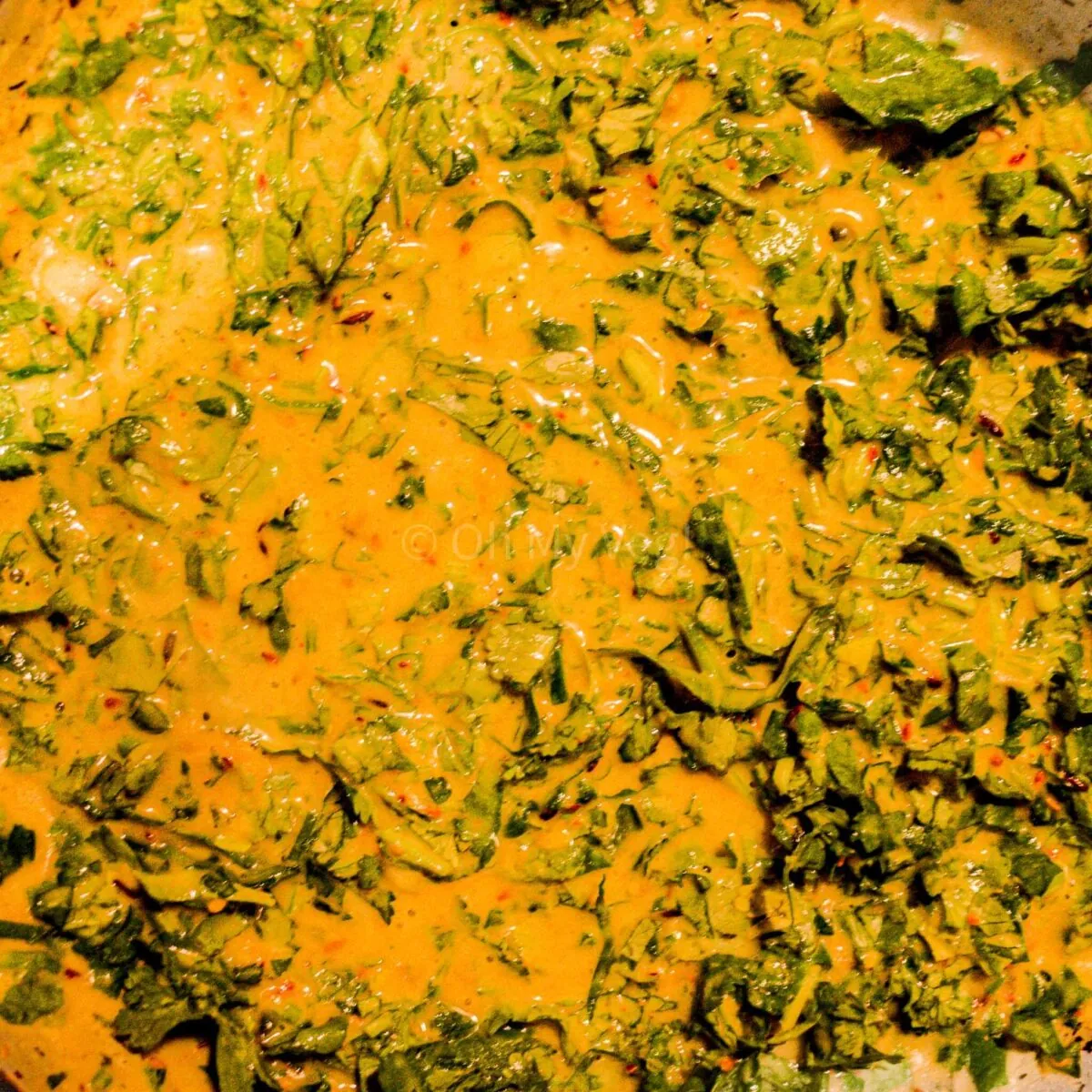
Ten: Add the chickpea flour and spice batter to the pan, along with the chopped coriander. Stir and cook until thickened.
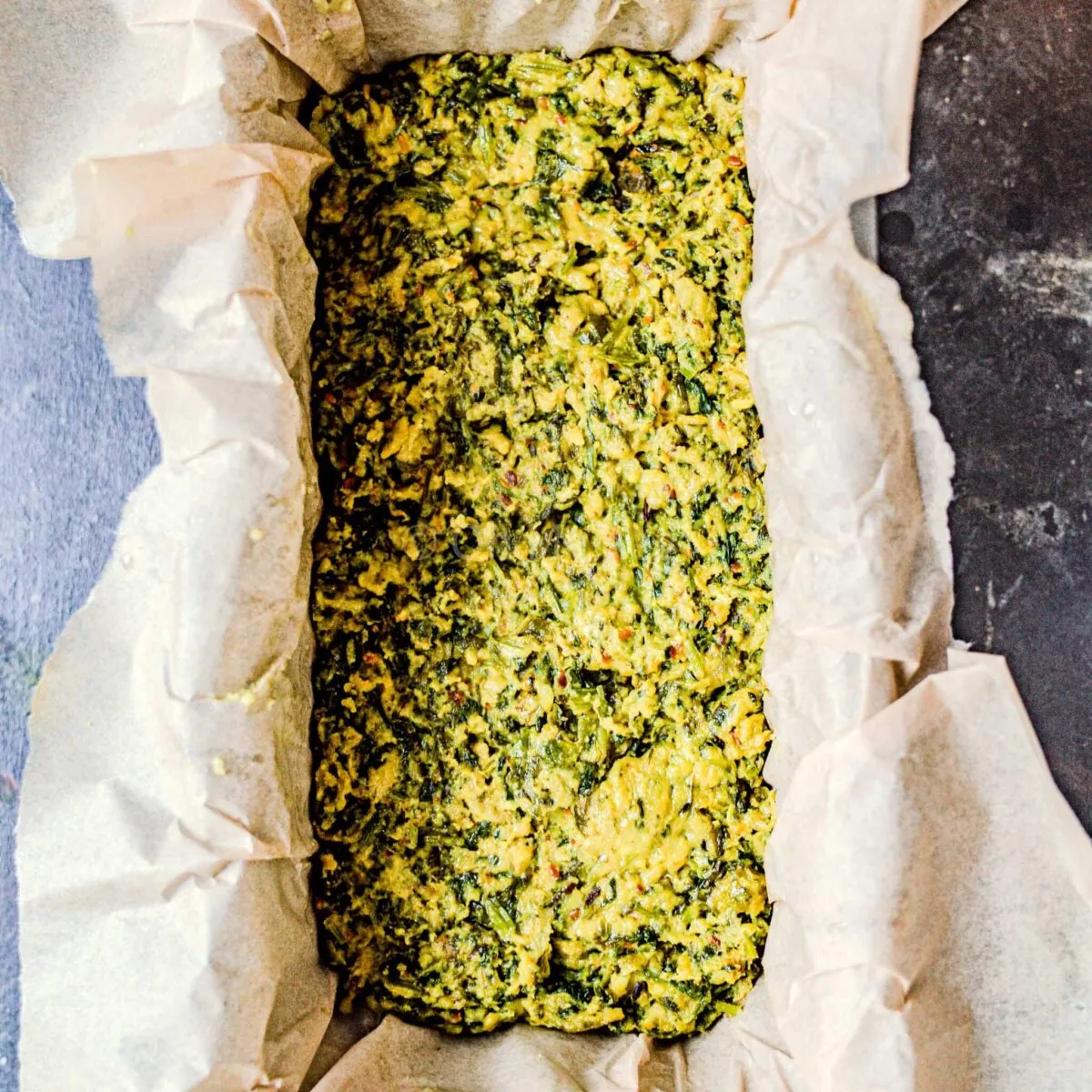
Eleven: Pour the mixture into a pan lined with parchment paper.
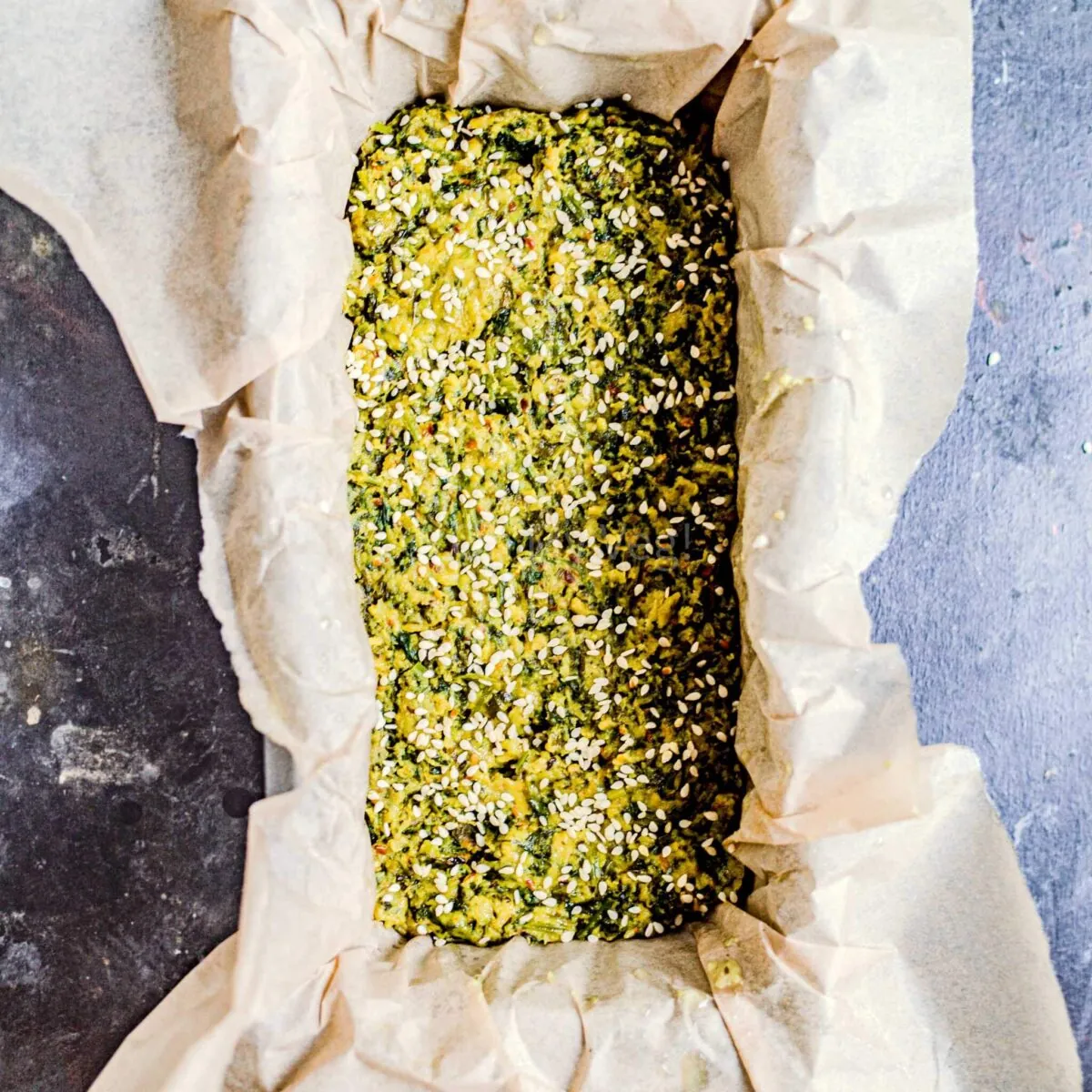
Twelve: Sprinkle extra white sesame seeds over the kothimbir vadi batter. Leave the mixture to cool and set.
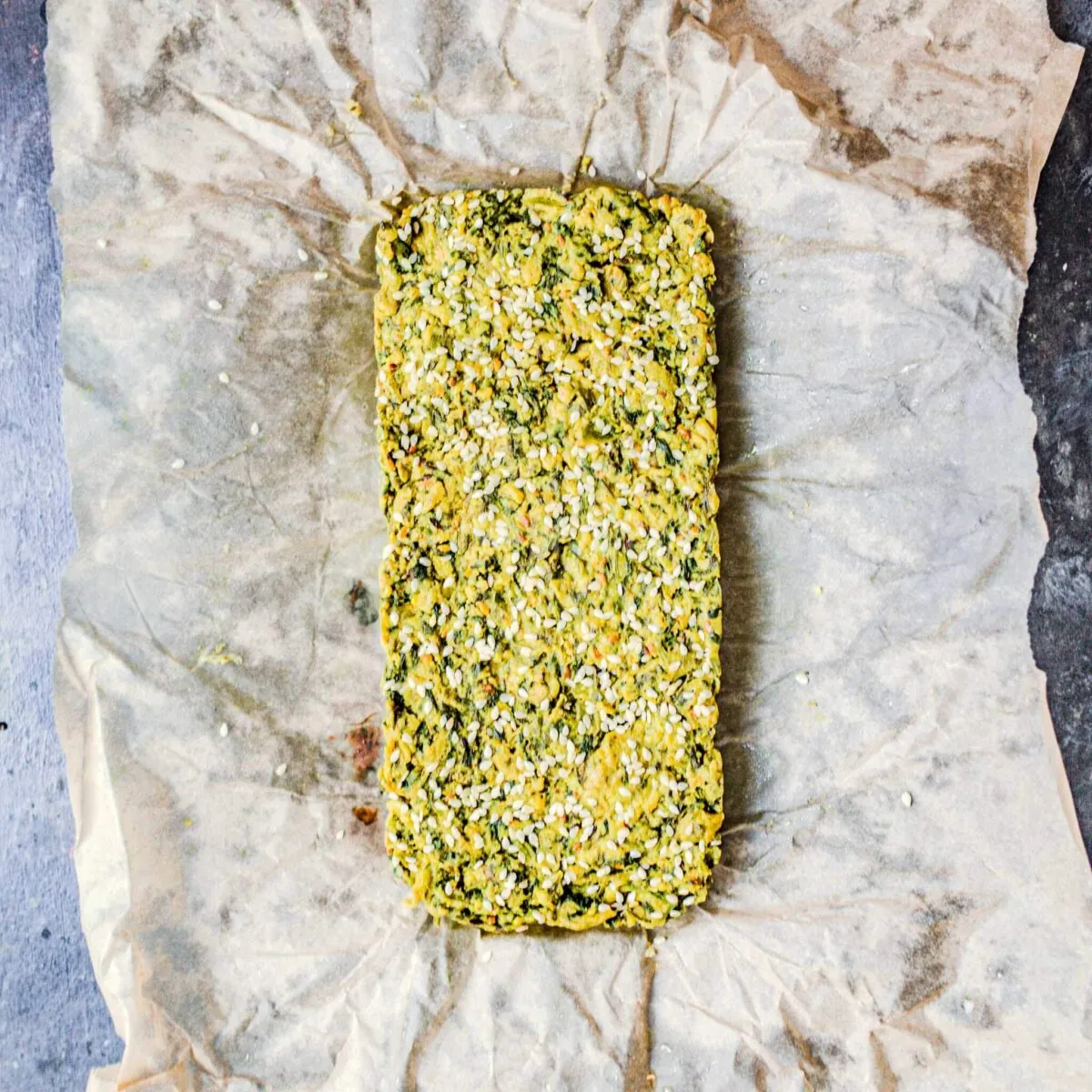
Thirteen: Remove the kothimbir vadi from the pan.
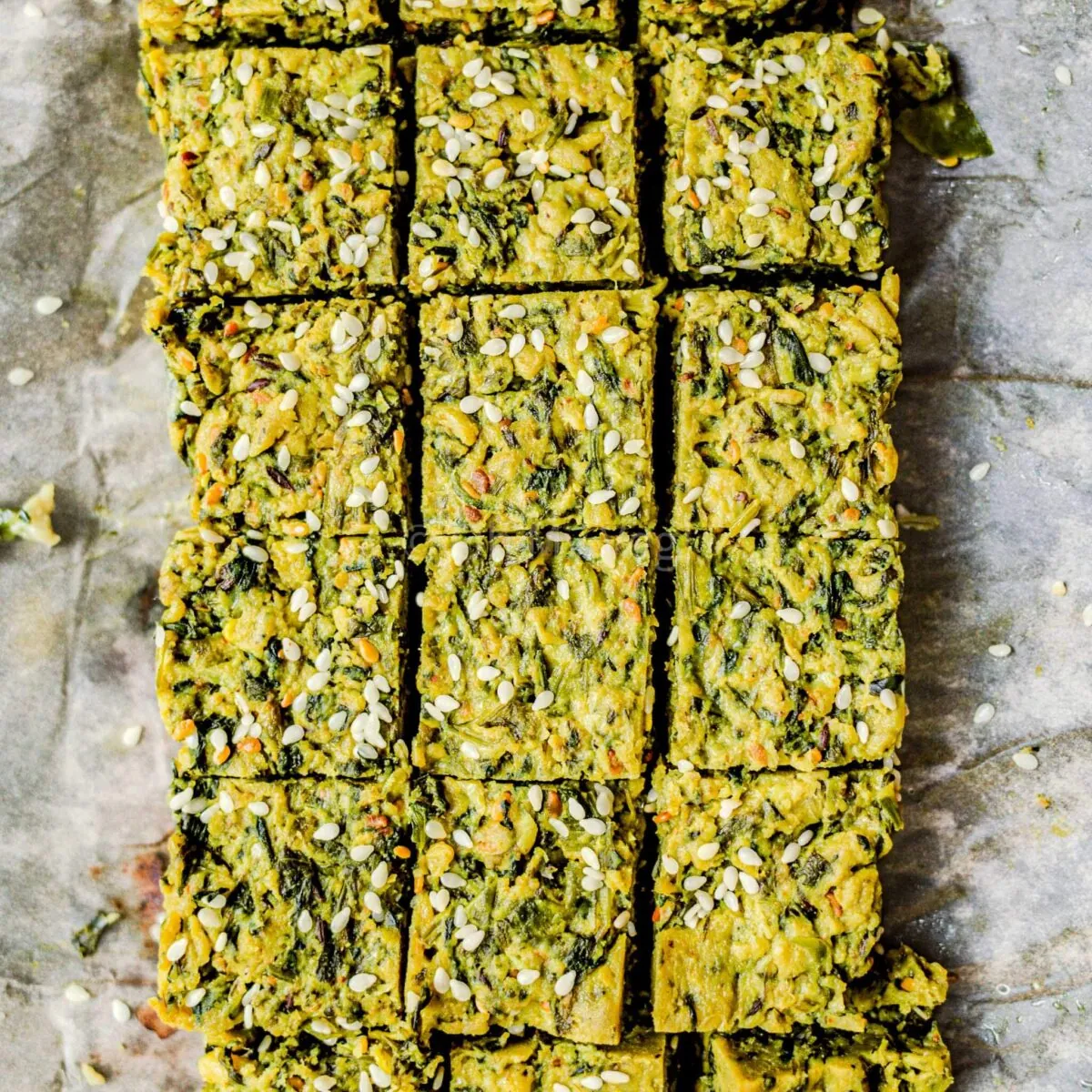
Fourteen: Grease a knife and cut the slab into evenly sized pieces. Squares, diamonds, or even rectangles are all great!
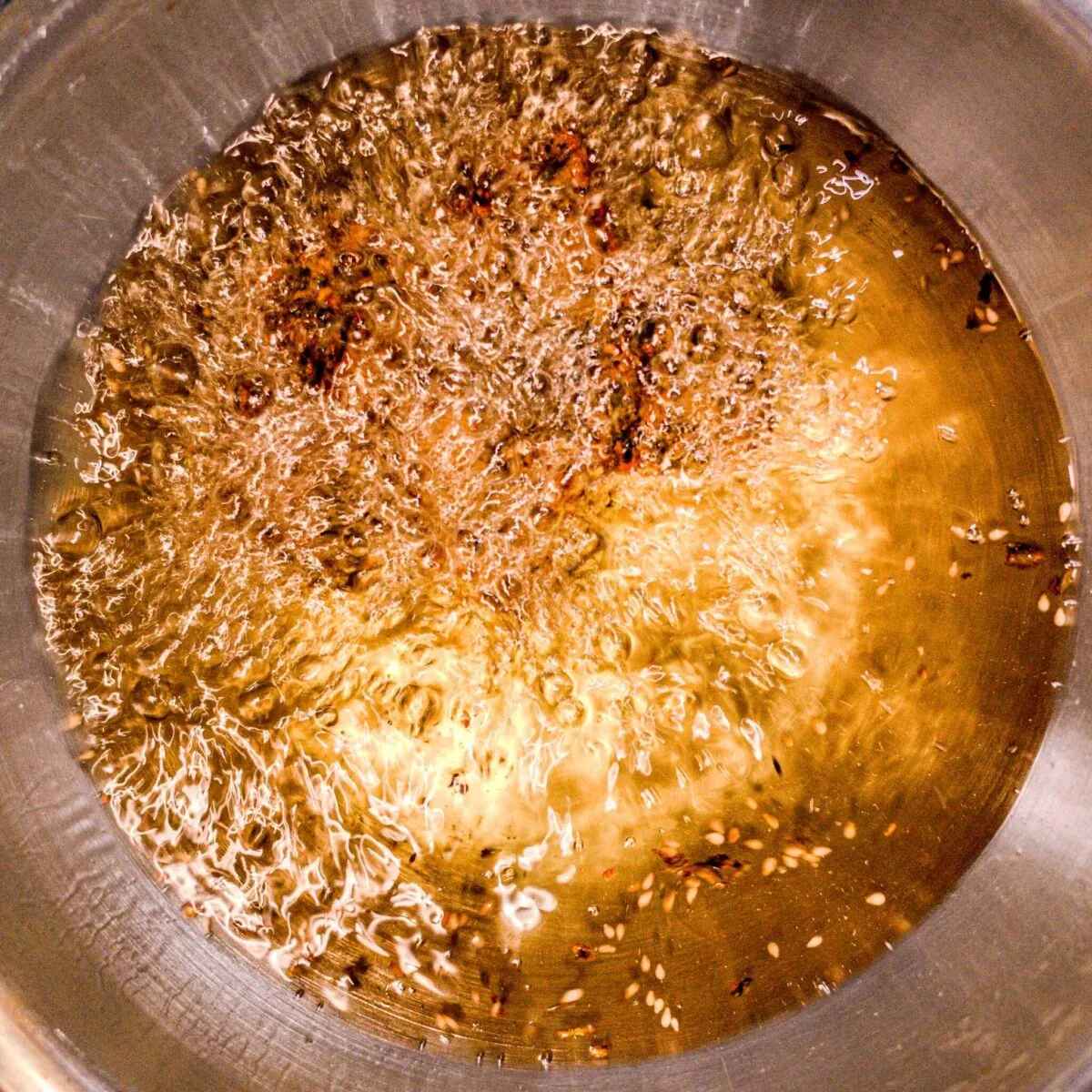
Fifteen: Heat neutral oil in a deep-fat fryer or kadai. Once hot, add the kothimbir vadi, and fry until golden-brown.
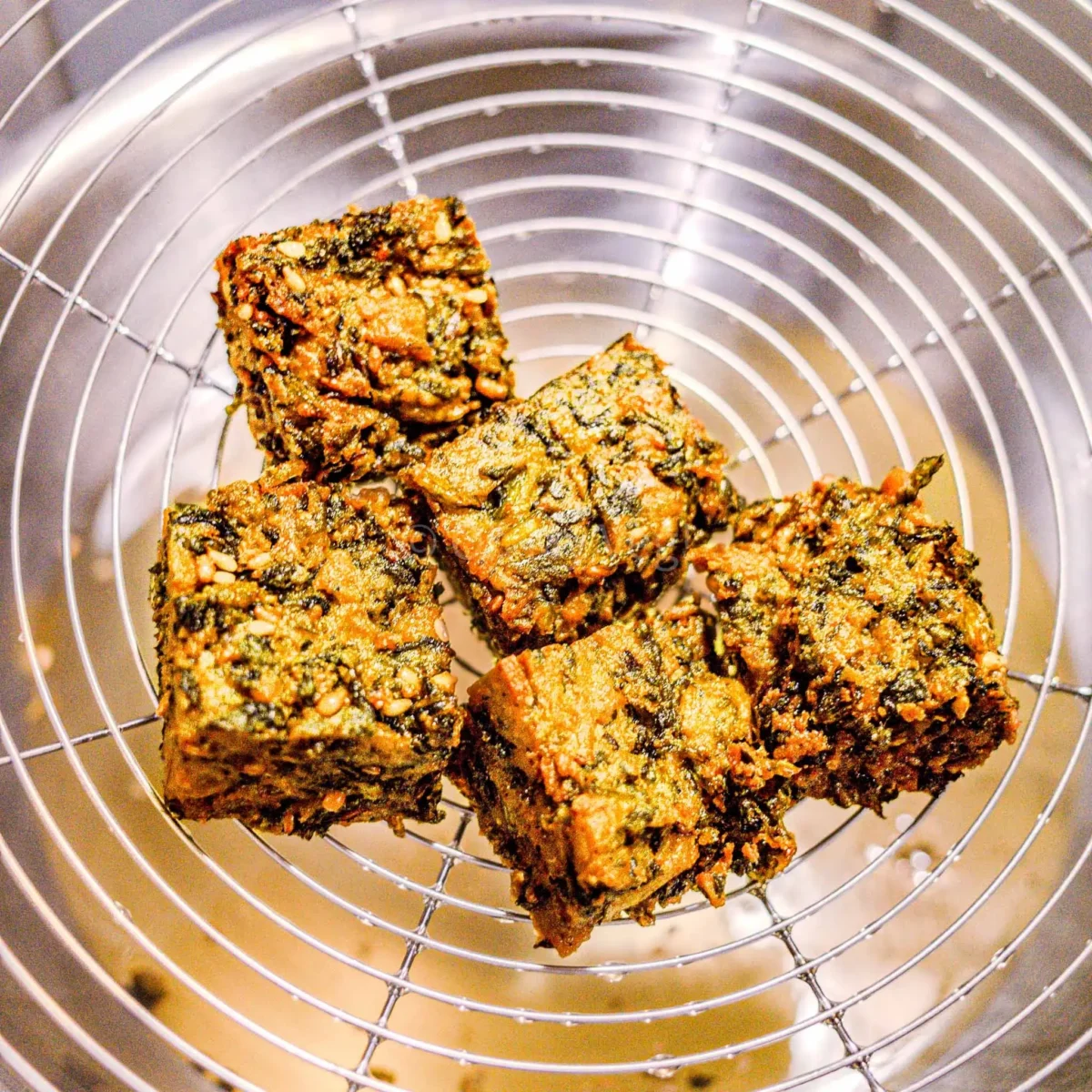
Sixteen: Use a spoon to carefully drain the kothimbir vadi of excess oil. Repeat the process, then serve.
The complete recipe (with ingredient quantities and instructions) can be found at the bottom of this page. You can also print the recipe, save the recipe, adjust the servings, and much more from there!
Alternative Cooking Methods
As mentioned above, this recipe is for kothimbir vadi without steaming. I’ve shared it as my main choice because it’s more accessible for people without access to a steamer (that was me for a long time!).
However, the most classic method for making kothimbir wadi is a bit different.
To make steamed kothimbir vadi, mix everything into a batter without cooking first: chickpea flour, ground spices, cumin seeds, sesame seeds, garlic, green chilli, and coriander leaves. Then, pour the batter into a deep steamer tray/plate, sprinkle with sesame seeds, and steam until set.
Both methods take roughly the same amount of time.
While this is typically only the first step of cooking, you can make kothimbir vadi without frying. Lots of people enjoy the softer taste of steamed kothimbir vadi!
Alternatively, if you’re wondering “Can I oven bake kothimbir vadi?”, “Can I air-fry kothimbir vadi?” or “Can I shallow fry kothimbir vadi?” The answer is YES!
The result won’t be quite as khushkhushit — a Marathi word that means crispy and flaky, with a dense, soft interior.
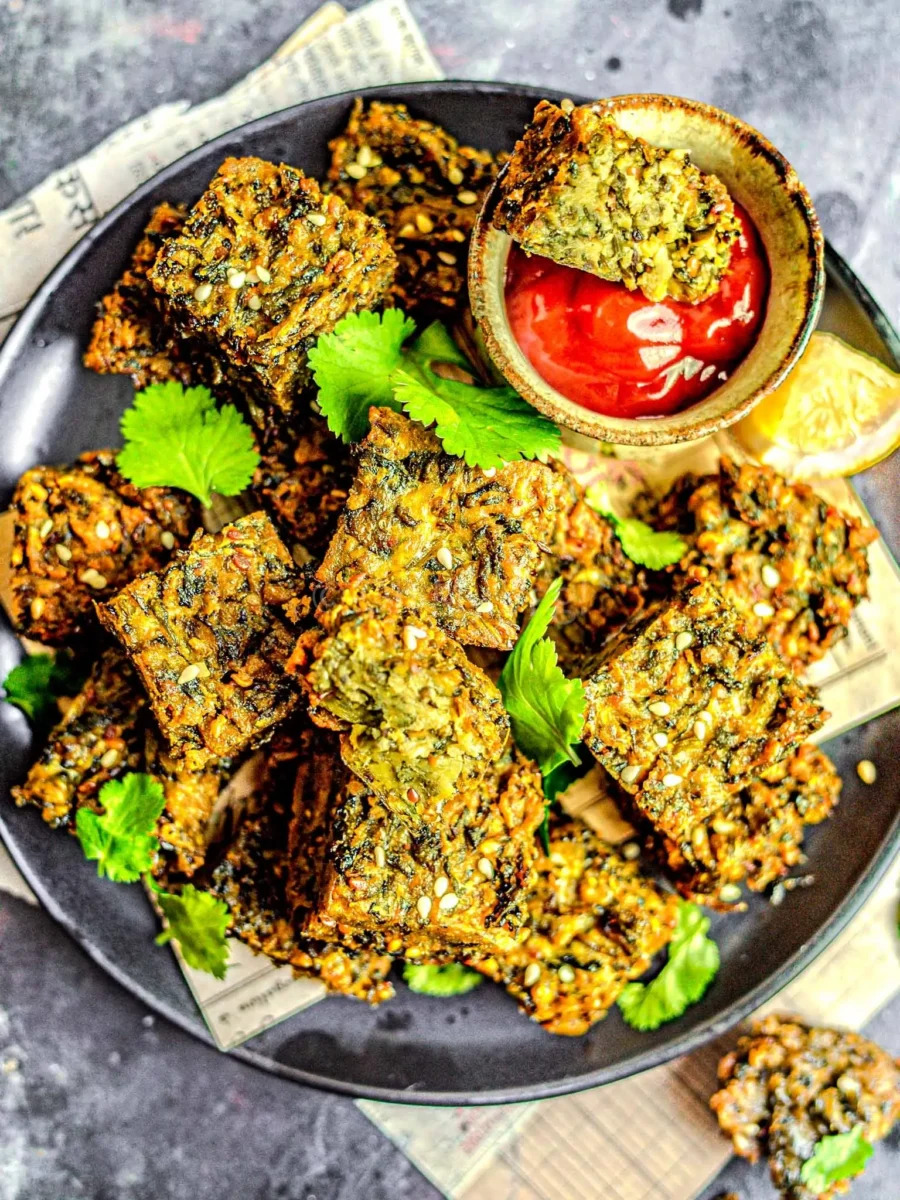
🌟My Top Tips for the Best Kothimbir Vadi
- Let the kothimbir vadi cool after leaving it to set in the pan. If you cut the fritters while the batter is still too warm, they run the risk of breaking.
- For really professional looking kothimbir wadi, use a ruler or similar measuring tool to evenly space out your cuts. You can eye it, but I’m never that accurate!
- Grease your knife before cutting the kothimbir vadi. It stops the steamed fritters from lifting, ensuring nice clean lines. It makes it much easier to do the washing up, too!
- Fry in batches and don’t overcrowd the pan. Whenever you’re deep-frying, this is KEY! Overcrowding the pan brings the oil temperature down, resulting in soggy, greasy kothimbir wadi that have soaked up far too much oil. Ugh!
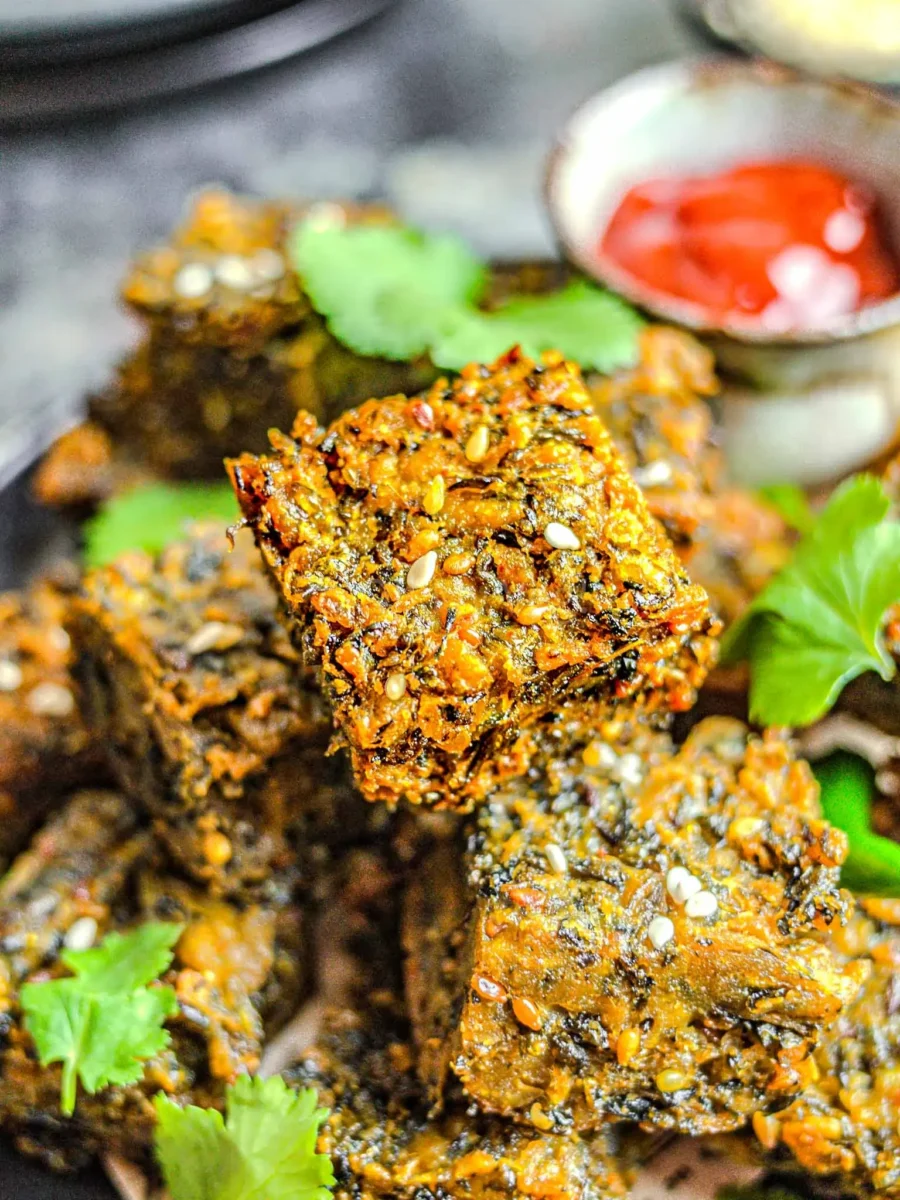
🥡Storage
Refrigerate kothimbir vadi in an airtight container for up to four days.
If possible, I prefer storing steamed kothimbir vadi. Although the fried treats also store well, it’s much easier to crisp up the steamed ones without overcooking.
Kothimbir vadi freeze well, too. Arrange them on a tray covered in parchment paper and freeze until solid, before transferring to a freezer-safe bag or container. This stops the vadi sticking together. Similar to the above, it’s best to freeze them steamed, but fried also works.
Reheat in a pan over medium-high heat. I don’t recommend the microwave here; it ruins the texture.
🍽️What to Eat With Kothimbir Vadi
Kothimbir vadi is lovely on it’s own, but there’s plenty more options.
If I just want a snack, I usually opt for kothimbir vadi with chai (chaha in Marathi). Plain tea, masala chai, or adrak chai — any one tastes fantastic. It’s the combination of the crunchy bites plus a steaming hot aromatic beverage that does the drink!
Not a tea drinker? Try kothimbir vadi with chutney. Depending on your mood, you could pair the snacks with chilli chutney if you like fireworks, mango chutney for fruity contrast, green chutney to complement the herbaceous fritters, or plain ‘ole ketchup (surprisingly, this is a favourite in India).
Ambitious? I definitely recommend putting together a Maharashtrian thali with dishes like puri (or butter chapati), flower batata rassa, varan bhaat, kurdai, and aamras or shrikhand (maybe combine both with aamrakhand!).
I’m getting hungry just writing about all these delicious combinations, so if you’re drooling too, let’s get cooking! A printable recipe is below.
If you tried this kothimbir vadi recipe — or any other recipe on my website — please leave a 🌟 star rating and let me know your thoughts in the ✍️comments at the bottom of the page. Thanks for being a part of my community!
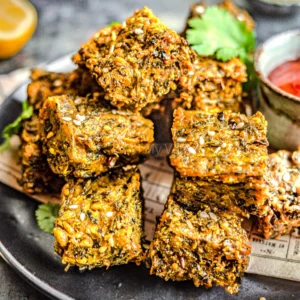
Kothimbir Vadi Recipe
Ingredients
- 100 g fresh coriander cilantro
- 50 g chickpea flour besan/garbanzo bean flour
- 400 ml water
- sea salt to taste
- ⅛ teaspoon red chilli powder
- ½ teaspoon coriander powder
- ¼ teaspoon turmeric powder
- ¼ teaspoon ajwain seeds
- 3 green finger chillies I use jwala
- 5 cloves garlic
- 1 tablespoon oil
- ½ teaspoon cumin seeds
- 1 tablespoon white sesame seeds
- 1 litre oil to deep fry
Instructions
- Prepare 100 g fresh coriander. First, wash it thoroughly (fresh coriander is sometimes muddy!), then pat dry. Roughly chop. You can use tender (thin) stalks as well as the leaves for less food waste. Coriander stalks are packed with flavour!
- Add 50 g chickpea flour to a large bowl. Slowly whisk in 400 ml water a little at a time (to avoid lumps). Then add sea salt (to taste), ⅛ teaspoon red chilli powder, ½ teaspoon coriander powder, ¼ teaspoon turmeric powder, and ¼ teaspoon ajwain seeds (crushed between your palms). Mix well.
- Use a mortar and pestle to crush 3 green finger chillies and 5 cloves garlic to a coarse paste.
- Add 1 tablespoon oil to a large kadai/deep frying pan over medium heat. Once the oil is hot, add ½ teaspoon cumin seeds and most of the 1 tablespoon white sesame seeds (reserve some for garnishing later). Cook until aromatic and just a touch coloured, then add the garlic-chilli paste. Sauté until aromatic.
- Turn the heat to low and add the chickpea flour-spices mixture. Stir every now and then to prevent it sticking to the pan. Cook until the mixture thickens (you'll need to stir more continuously once this begins happening), which can take around 20 minutes.
- Once the batter has thickened, pour it into a loaf tin (or similar sized tin) lined with parchment paper. Sprinkle the leftover sesame seeds on top. Move to the fridge to cool.
- Once set and cooled, remove the parchment paper and set kothimbir vadi from the tin. Grease a knife with oil and cut into 18 evenly-sized squares.
- Preheat 1 litre oil in a deep-fat fryer or deep kadai over medium-high heat. Once the oil comes to temperature (if it bubbles around a wooden spoon handle, it's ready!), carefully lower in a few pieces of kothimbir vadi. Fry until golden brown, then drain any excess oil on kitchen towel. Repeat with the remaining wadi.

